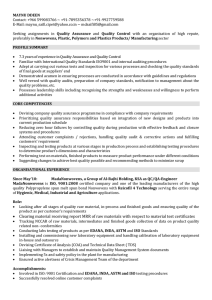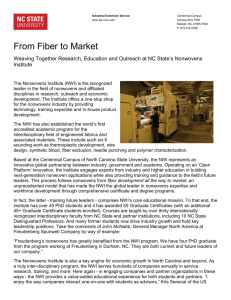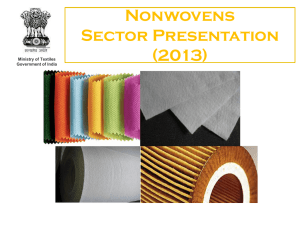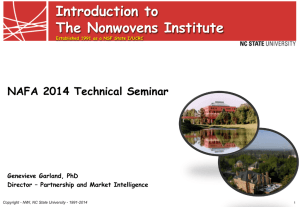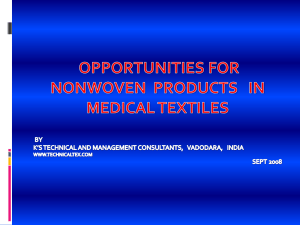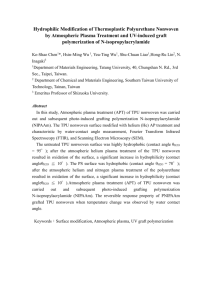Antimicrobial Activity of Filtrating Meltblown Nonwoven with the Addition of Silver Ions
advertisement
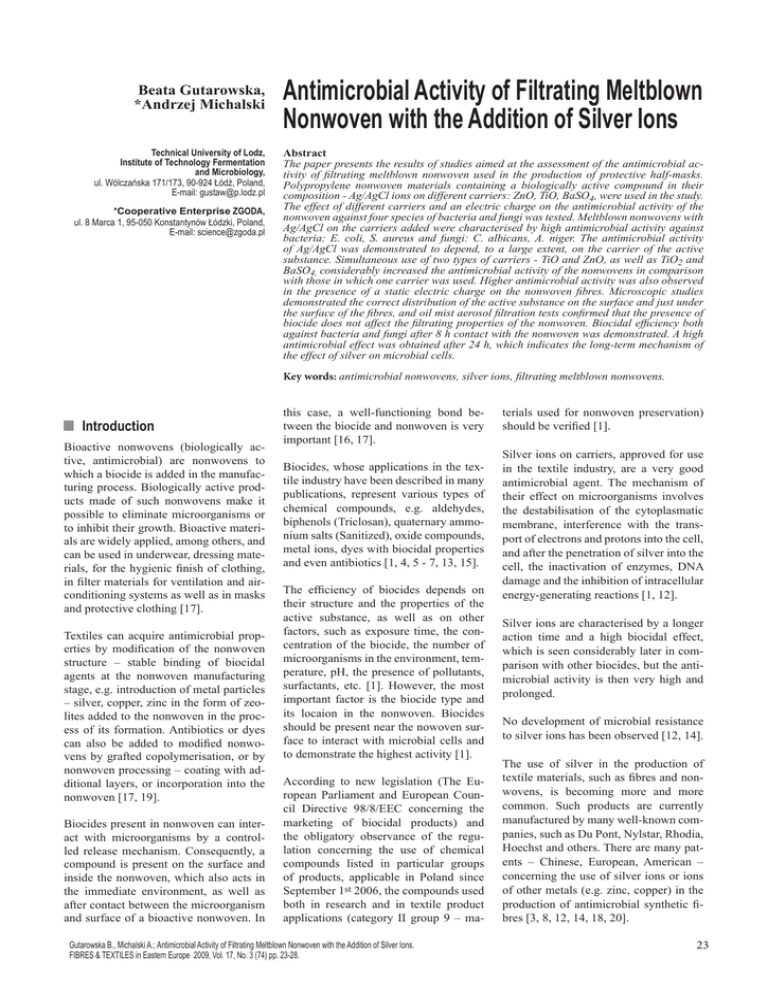
Beata Gutarowska, *Andrzej Michalski Technical University of Lodz, Institute of Technology Fermentation and Microbiology, ul. Wólczańska 171/173, 90-924 Łódź, Poland, E-mail: gustaw@p.lodz.pl *Cooperative Enterprise ZGODA, ul. 8 Marca 1, 95-050 Konstantynów Łódzki, Poland, E-mail: science@zgoda.pl Antimicrobial Activity of Filtrating Meltblown Nonwoven with the Addition of Silver Ions Abstract The paper presents the results of studies aimed at the assessment of the antimicrobial activity of filtrating meltblown nonwoven used in the production of protective half-masks. Polypropylene nonwoven materials containing a biologically active compound in their composition - Ag/AgCl ions on different carriers: ZnO, TiO, BaSO4, were used in the study. The effect of different carriers and an electric charge on the antimicrobial activity of the nonwoven against four species of bacteria and fungi was tested. Meltblown nonwovens with Ag/AgCl on the carriers added were characterised by high antimicrobial activity against bacteria: E. coli, S. aureus and fungi: C. albicans, A. niger. The antimicrobial activity of Ag/AgCl was demonstrated to depend, to a large extent, on the carrier of the active substance. Simultaneous use of two types of carriers - TiO and ZnO, as well as TiO2 and BaSO4, considerably increased the antimicrobial activity of the nonwovens in comparison with those in which one carrier was used. Higher antimicrobial activity was also observed in the presence of a static electric charge on the nonwoven fibres. Microscopic studies demonstrated the correct distribution of the active substance on the surface and just under the surface of the fibres, and oil mist aerosol filtration tests confirmed that the presence of biocide does not affect the filtrating properties of the nonwoven. Biocidal efficiency both against bacteria and fungi after 8 h contact with the nonwoven was demonstrated. A high antimicrobial effect was obtained after 24 h, which indicates the long-term mechanism of the effect of silver on microbial cells. Key words: antimicrobial nonwovens, silver ions, filtrating meltblown nonwovens. n Introduction Bioactive nonwovens (biologically active, antimicrobial) are nonwovens to which a biocide is added in the manufacturing process. Biologically active products made of such nonwovens make it possible to eliminate microorganisms or to inhibit their growth. Bioactive materials are widely applied, among others, and can be used in underwear, dressing materials, for the hygienic finish of clothing, in filter materials for ventilation and airconditioning systems as well as in masks and protective clothing [17]. Textiles can acquire antimicrobial properties by modification of the nonwoven structure – stable binding of biocidal agents at the nonwoven manufacturing stage, e.g. introduction of metal particles – silver, copper, zinc in the form of zeolites added to the nonwoven in the process of its formation. Antibiotics or dyes can also be added to modified nonwovens by grafted copolymerisation, or by nonwoven processing – coating with additional layers, or incorporation into the nonwoven [17, 19]. Biocides present in nonwoven can interact with microorganisms by a controlled release mechanism. Consequently, a compound is present on the surface and inside the nonwoven, which also acts in the immediate environment, as well as after contact between the microorganism and surface of a bioactive nonwoven. In this case, a well-functioning bond between the biocide and nonwoven is very important [16, 17]. Biocides, whose applications in the textile industry have been described in many publications, represent various types of chemical compounds, e.g. aldehydes, biphenols (Triclosan), quaternary ammonium salts (Sanitized), oxide compounds, metal ions, dyes with biocidal properties and even antibiotics [1, 4, 5 - 7, 13, 15]. The efficiency of biocides depends on their structure and the properties of the active substance, as well as on other factors, such as exposure time, the concentration of the biocide, the number of microorganisms in the environment, temperature, pH, the presence of pollutants, surfactants, etc. [1]. However, the most important factor is the biocide type and its locaion in the nonwoven. Biocides should be present near the nowoven surface to interact with microbial cells and to demonstrate the highest activity [1]. According to new legislation (The European Parliament and European Council Directive 98/8/EEC concerning the marketing of biocidal products) and the obligatory observance of the regulation concerning the use of chemical compounds listed in particular groups of products, applicable in Poland since September 1st 2006, the compounds used both in research and in textile product applications (category II group 9 – ma- Gutarowska B., Michalski A.; Antimicrobial Activity of Filtrating Meltblown Nonwoven with the Addition of Silver Ions. FIBRES & TEXTILES in Eastern Europe 2009, Vol. 17, No. 3 (74) pp. 23-28. terials used for nonwoven preservation) should be verified [1]. Silver ions on carriers, approved for use in the textile industry, are a very good antimicrobial agent. The mechanism of their effect on microorganisms involves the destabilisation of the cytoplasmatic membrane, interference with the transport of electrons and protons into the cell, and after the penetration of silver into the cell, the inactivation of enzymes, DNA damage and the inhibition of intracellular energy-generating reactions [1, 12]. Silver ions are characterised by a longer action time and a high biocidal effect, which is seen considerably later in comparison with other biocides, but the antimicrobial activity is then very high and prolonged. No development of microbial resistance to silver ions has been observed [12, 14]. The use of silver in the production of textile materials, such as fibres and nonwovens, is becoming more and more common. Such products are currently manufactured by many well-known companies, such as Du Pont, Nylstar, Rhodia, Hoechst and others. There are many patents – Chinese, European, American – concerning the use of silver ions or ions of other metals (e.g. zinc, copper) in the production of antimicrobial synthetic fibres [3, 8, 12, 14, 18, 20]. 23 Silver is used in the form of monomolecules suspended in silver oxide and introduced into the polymer from which nonwoven is produced [20]. The use of silver compounds as a protective layer on the nonwoven surface is known [20]. Nonwovens obtained in this way have a limited biological activity since only the nonwoven surface, with a biocide applied onto it, is active; however, this activity wears off with time because of the detachment of the active compound molecules from the nowoven surface. The study presented involved the search for new technological solutions for the production of biologically active nonwovens to be used for health (protective masks) and environmental protection (filters in ventilation and air-conditioning systems). The aim of the study was to obtain biologically active nonwovens containing silver ions on inorganic carriers with high levels of antibacterial and antifungal activity. Experiments were carried out on test microorganisms – representatives of Gram-positive (Staphylococcus aureus) and Gram-negative bacteria (Escherichia coli) as well as fungi representing yeasts (Candida albicans) and moulds (Aspergillus niger). The test bacteria represent various morphological and physiological forms which determine their varied resistance to disinfectants. E. coli is highly resistant to disinfectants because of the presence of lipopolysaccharide in the external membrane. This bacterium belongs to a group of opportunistic saprophytes which can cause gastrointestinal disorders. S. aureus represents a typical microflora present in the air, which is a cause of respiratory system infections in humans. The Yeast-like fungi C. albicans are opportunistic human pathogens, common in the environment in which people live (present on mucous membranes), which are responsible for dermatoses and can infest the reproductive system and gastrointestinal tract. A. niger, a filamentous fungus, was selected for the tests because of its common occurrence in indoor environments and high resistance to disinfectants. It can cause opportunistic mycoses in humans [8, 10, 11]. n Experimental Material and methods Nonwovens Polypropylene meltblown nonwovens with the addition of an active substance – silver in the Ag/AgCl form on different carriers: titanium oxide (TiO2 – marked as T), barium sulphate (BaSO4 – marked as B), zinc oxide (ZnO – marked as L) were tested. The nonwovens were made of polypropylene, whose trade name is Malen S-901 (Orlen , Płock) and produced by blowing molten polymer at a temperature ≥ 300 °C. Nonwovens were produced with and without an electric charge applied - under 25 kV voltage. Before processing the polypropylene into nonwoven, an active substance in the form of poly propylene concentrate, known under the trade name of COLORSVIT 9212-PP-30/T, B or L, containing 30% Ag/AgCl, was added. The concentrate was obtained from the Institute of Chemical Fibres in Svit, Slo- Table 1. Bioactive nonwoven types tested. 24 Sample code Added concentrate containing 30% Ag/AgCl with an appropriate carrier Presence of static charge (no: -; yes:+) WP1/0 Control without concentrate - WP1/e Control without concentrate + B/0 BaSO4 - B/e BaSO4 + T/0 TiO2 - T/e TiO2 + L/0 ZnO - L/e ZnO + BT/0 BaSO4 + TiO2 - BT/e BaSO4 + TiO2 + BL/0 BaSO4 + ZnO - BL/e BaSO4 + ZnO + TL/0 TiO2 + ZnO - TL/e TiO2 + ZnO + vakia and used in the amount of 3% by weight in relation to the polypropylene. The nonwovens characterised in Table 1 were tested for biological activity. The filtration properties of the nonwovens were tested with paraffin oil aerosol flow according to PN-EN 149:2004. The aerosol flow rate was 95 l/min. Microscopic images of the nonwovens were obtained with a Quanta 200(W) SEM manufactured by FEI Company in order to check the distribution of active substances on the surface and inside the nonwovens. Microorganisms Microorganisms from the American Type Culture Collection: Escherichia coli ATCC 10536, Staphylococcus aureus ATCC 6538 and from the Collection of Pure Cultures Łock of the TUL Institute of Fermentation Technology and Microbiology: Aspergillus niger Łock 0439, Candida albicans Łock 0001 were used in the tests. Tests of antimicrobial activity of the nonwovens Samples of nonwoven of 6.25 cm2 surface area were placed in sterile Petri dishes. Inoculum suspensions of respective densities determined by the culture method, reaching the following levels: E. coli - 2,0×107 CFU/ml, S. aureus - 5,0×107 CFU/ml, A. niger - 8,0×105 CFU/ml, C.albicans - 1,5×107 CFU/ml, were prepared. The research method was based on AATCC 100-1998 methodology – procedure of qualitative determination of antibacterial activity of a textile material. All the textile samples were inoculated with 0.1 ml of the inoculum suspension of a particular microorganism. Each material sample (repeated 4 times, because of the 4 exposure times tested) was inoculated by the inoculum suspension prepared and left to incubate at temp. 27 °C (fungi) and 30 °C (bacteria). The samples were collected after 0, 4, 8, and 24 hours after material inoculation. Afterwards the textile samples were transferred to sterile physiological saline, then the microorganisms were washed out and shaken for 15 minutes in an aqueous bath. After that the suspension of bacteria was diluted with sterile physiological saline and inFIBRES & TEXTILES in Eastern Europe 2009, Vol. 17, No. 3 (74) oculated onto a sterile Petri plate. Each sample was immersed in a semi-liquid culture medium - TSA (bacteria) or MEA (fungi), mixed and left until it set. Then the inoculated plates were incubated at 30 °C for 24 h (bacteria), and at 27 °C for 48 - 72 h (fungi). Afterwards all the colonies grown were counted. Interpretation of results The results obtained were used for calculation of the mean values for each microorganism for a particular hour of exposure and given nonwoven type. The results were expressed in CFU (Colony Forming Units) per sample, which reflected the dynamics of changes in microbial counts during the exposure to the nonwovens. Antimicrobial activity was expressed as biocidal activity (A) and biostatic activity (S). A value of A(S)<0.4 was classified as low, whereas A(S)>0.4, i.e. a 3-fold reduction in CFU, was classified as good. The biocidal activity (A) was calculated using the following formula: A = log C0/Btn (1) where: C0 - CFU per sample after time t0 of exposure to the particular nonwoven containing no biocide (control sample) Btn - CFU per sample after time tn of exposure to the particular nonwoven containing a biocide. as meltblown nonwovens with no such charge are not used for the production of protective half-masks. Table 2. Filtration properties of bioactive nonwovens tested with paraffin oil aerosol. Sample code Penetration, % Resistance, Pa WP1/e 4.3 151.4 WP1/e 3.8 152.1 B/e 4.3 151.6 B/e 4.0 152.4 T/e 3.5 163.9 T/e 4.5 151.3 L/e 4.4 142.8 L/e 3.8 153.1 BT/e 3.9 150.4 BT/e 3.5 162.7 BL/e 3.4 155.4 BL/e 3.7 151.3 TL/e 4.5 152.8 TL/e 3.3 160.8 The results obtained indicate that the filtration properties of nonwovens are not dependent on the presence of a bioactive agent. The level of penetration of paraffin oil aerosol was similar – within the 3.3% to 4.5% range – for both the control nonwoven WP1/e and bioactive nonwovens. The same relation was observed with respect to the resistance of the nonwovens tested. Microscopic images of the fibres selected are presented in Figure 1. They indicate that active substance molecules are located both inside the nonwovens, just under the surface, and on their surface, which may have a favorable effect on their biological activity. The results concerning changes in the microbial counts of the samples during incubation are presented in Table 3 (see page 26). The counts of all the analysed microorganisms present on the nonwovens were found to decrease with the time of exposure. However, it could be observed that bacteria (E. coli and S. aureus) died more slowly than fungi (A. niger and C. albicans). It was also found that nonwovens with an electric charge (.../e) cause more rapid decreases in microbial counts than non-charged ones. Nonwovens TL, B, BL for S. aureus, nonwoven TL for E. coli and nonwoven L for C. albicans were the exceptions, where a larger decrease in the number of microorganisms was observed in nonwovens without an electric charge. There were also differences in the decreases in microbial counts due to the use of nonwovens with different silver carriers. A considerable decrease in microbial counts (CFU) was observed in control a) b) c) d) The biostatic activity (S) was calculated using the follwing formula: S = log Ctn/Btn (2) where: Ctn - CFU per sample after time tn of exposure to the particular nonwoven containing no biocide (control sample) Btn - CFU per sample after time tn of exposure to the particular nonwoven containing a biocide. Statistical analysis of the results regarding the number of microorganisms: mean, standard deviation and Pearson’s coefficients were determined using the computer program Excel. n Results Results concerning the filtration properties of bioactive nonwovens are presented in Table 2. Only nonwovens containing a static electric charge were analysed FIBRES & TEXTILES in Eastern Europe 2009, Vol. 17, No. 3 (74) Figure 1. Microphotos of nonwoven: a - without any active agent, b, c, d - with silver (Ag/AgCl added to the: b - TiO2 carrier, c - TiO2/ZnO carrier,d - BaSO4 carrier. 25 Table 3. Number of microorganisms in cfu/sample during the incubation of bioactivity nonwovens with microorganisms; EC - E. coli, SA - S. aureus, AN - A. niger, CA - C. albicans; X - mean, S - standard deviation, V - Pearson’s coefficient in %. WP1/0 Incubation time, h WP1/e EC SA AN CA EC SA AN CA X S V X S V 2.9×106 6.1×105 21 1.2×106 4.1×105 32 1.6×106 1.9×105 12 1.5×106 6.4×105 43 4.3×104 5.7×103 13 4.2×104 7.6×103 18 1.6×106 7.0×105 43 9.0×105 1.0×105 11 2.7×106 2.4×105 9 1.1×106 1.0×105 9 1.5×106 1.5×105 10 1.4×106 4.4×105 31 3.8×104 1.0×104 27 3.3×104 3.5×103 11 1.4×106 5.7×105 42 6.3×105 3.5×104 6 X S V X S V 8.6×105 1.4×105 17 6.2×105 2.8×104 5 1.1×106 4.7×105 42 2.9×105 5.6×103 2 1.4×104 1.5×103 11 3.7×103 1.5×103 41 5.3×105 2.2×105 41 2.2×104 2.8×103 13 6.8×105 2.4×105 35 1.7×103 5.7×102 35 1.1×106 3.1×105 28 1.2×105 3.4×104 28 9.5×103 7.0×102 7 3.3×103 3.5×102 11 4.6×105 1.7×105 37 1.1×105 2.1×104 16 0 X S V 2.6×106 4.6×105 17 1.5×106 4.4×105 30 4.2×104 1.1×104 25 1.3×106 2.0×105 16 2.6×106 1.5×105 5 1.4×106 3.0×105 21 4.8×104 7.0×103 14 1.1×106 2.3×105 21 4 X S V 1.6×106 4.1×105 V; 25 2.1×105 2.2×105 1 3.8×104 1.0×104 27 7.6×105 8.5×104 11 2.1×106 7.3×105 35 9.2×105 3.8×104 4 2.8×104 1.4×103 5 4.7×105 6.4×104 13 X S V X S V 9.4×105 2.9×105 31 8.3×104 2.1×104 25 4.6×105 1.7×105 37 3.3×104 3.9×103 10 2.4×104 2.8×103 12 9.0×103 1.4×103 15 5.6×105 8.6×104 15 7.2×104 1.7×104 24 5.5×105 9.1×104 16 7.8×103 2.5×103 32 1.1×106 2.4×105 22 2.7×105 9.9×104 36 1.1×104 7.0×102 7 3.8×103 1.0×103 27 4.2×105 5.6×103 1 2.1×104 1.0×104 49 0 X S V 2.5×106 5.0×105 20 1.4 ×106 4.0×105 28 4.9×104 9.6×103 19 1.1×106 6.1×104 5 2.8×106 1.1×105 4 1.6×106 1.9×105 11 4.3×104 5.7×103 13 1.1×106 3.3×105 30 4 X S V 1.3×106 3.0×105 24 9.7×105 4.4×105 45 4.2×104 7.6×103 18 9.5×105 5.0×104 5 1.5×106 6.9×105 47 9.7×105 4.0×104 4 3.0×104 1.5×103 5 3.5×105 6.3×1054 18 X S V X S V 7.8×105 1.5×105 19 7.0×104 1.0×104 14 5.8×105 3.4×104 6 2.6×105 1.1×105 41 2.8×104 2.5×103 9 8.5×103 5.0×102 6 6.5×105 1.4×105 21 1.2×104 4.5×103 38 7.9×105 2.1×105 27 9.0×103 4.5×102 5 8.8×105 2.8×105 32 6.9×105 7.0×103 1 1.7×104 4.9×103 30 5.5×103 1.5×103 27 1.7×105 3.5×104 20 3.5×103 7.0×102 20 X S V X S V X S V X S V 2.7×106 3.5×105 13 1.1×106 4.3×105 39 6.7×105 2.9×105 43 3.4×103 8.5×102 25 BT/0 1.6×106 4.5×104 5 1.5×10 1.3×104 10 29 1.4×106 4.8×104 5 3.6×10 1.0×104 26 21 1.2×106 1.5×104 5 4.8×10 7.0×103 42 47 1.5×105 4.0×103 4 4.2×10 0 27 0 1.3×106 2.1×105 17 7.6×106 8.1×104 10 1.3×105 3.2×104 25 5.6×104 1.9×104 34 2.8 ×106 1.7×105 6 1.2 ×106 5.4×105 43 6.8 ×105 2.9×105 43 1.3 ×103 3.5×102 28 BT/e 1.5×106 4.2×104 5 3.5×10 1.2×104 24 30 2.7×105 1.8×104 4 5.6×10 7.5×103 21 42 2.3×105 9.5×103 4 3.7×10 5.0×102 16 5 9.0×104 2.3×103 4 1.4×10 3.0×102 16 13 1.4×106 4.2×105 30 8.1×105 4.3×105 49 1.0×105 0 0 7.5×103 2.1×103 28 0 X S V 2.7×106 4.5×105 17 1.5×106 2.0×105 14 4.8×104 7.6×103 16 1.2×106 3.9×105 34 2.8×106 5.1×105 18 1.6×106 8.5×104 5 4.5×104 5.0×103 V; 11 1.3×106 6.1×104 5 4 X S V 1.6×106 5.7×105 35 8.1×105 5.4×104 6 4.2×104 1.6×104 38 7.2×105 1.2×105 17 9.2×105 3.5×105 38 7.7×105 2.1×105 27 2.6×104 5.3×103 V; 20 8.7×105 3.6×105 42 X S V X S V 1.2×105 2.7×104 23 2.9×104 5.6×103 19 6.9×105 2.8×105 40 1.7×105 2.8×104 16 4.2×103 1.0×103 25 1.1×103 1.4×102 13 3.9×105 1.7×105 45 7.7×103 2.5×103 33 2.9×105 3.9×104 13 7.5×104 3.5×104 47 7.1×105 8.5×103 1 4.9×105 7.1×103 1 1.5×104 4.7×103 32 1.0×103 0 0 3.4×105 3.6×104 10 1.1×103 7.1×101 7 0 X S V 2.9 ×106 4.1×105 13 1.4×106 2.1×105 15 4.8×104 7.6×103 16 1.3 ×106 1.3×105 10 2.9×106 6.2×105 22 1.5 ×106 4.9×105 34 3.9 ×104 1.0×104 25 1.2 ×106 1.8×105 15 4 X S V 2.1 ×106 6.3×105 31 1.1×106 1.8×105 16 4.2×104 1.1×104 25 5.2 ×105 1.7×105 32 1.2×106 2.5×105 20 1.3 ×106 6.1×105 48 2.7 ×104 7.0×103 25 6.4 ×105 1.5×105 23 X S V X S V 8.9 ×105 2.0×105 22 1.4 ×105 3.2×104 23 6.3×105 1.6×105 25 5.5×105 6.7×104 12 3.6×104 1.2×104 35 1.1×104 2.1×103 20 4.6 ×105 7.8×104 17 2.5 ×105 6.1×104 24 4.3×105 1.1×105 25 5.8×104 1.1×104 18 1.4 ×106 5.3×105 37 3.3×105 1.5×105 32 1.4 ×104 3.5×103 25 7.9 ×103 1.1×103 13 4.4 ×105 1.5×105 35 6.9 ×104 2.7×104 38 0 X S V 2.8 ×106 6.8×105 25 1.6 ×106 1.0×105 7 4.4 ×104 4.0×103 9 1.2×106 1.6×105 12 3.0 ×106 3.6×105 12 X.7 ×106 2.3×105 14 4.0 ×105 1.7×105 43 1.1 ×106 1.5×105 10 4 X S V 3.2 ×106 4.6×105 15 8.0 ×105 2.8×105 35 2.8 ×104 7.2×103 26 4.2×105 3.7×104 8 1.5 ×106 4.7×105 32 8.4 ×105 2.3×105 28 2.8 ×104 7.6×103 27 1.1 ×106 3.6×105 34 X S V X S V 2.9 ×105 1.2×105 42 7.3 ×104 1.5×104 21 5.1 ×105 1.1×105 22 2.0 ×105 2.6×104 13 1.3 ×104 3.2×103 26 1.0 ×104 1.3×103 12 3.8×105 8.5×104 22 1.3×104 3.5×103 28 5.3 ×105 2.5×105 47 2.4×103 8.5×102 35 7.9 ×105 2.8×105 36 8.3 ×104 3.8×104 46 1.6 ×104 4.9×103 30 9.3 ×103 3.1×103 33 1.8 ×105 1.6×104 9 2.7 ×104 4.2×103 16 0 4 8 24 BL/0 8 24 BL/e B/0 8 24 0 4 8 24 B/e TL/0 8 24 TL/e T/0 8 24 T/e L/0 8 24 26 L/e nonwovens without silver (WP1/...), particularly for E.coli; therefore the antimicrobial activity phenomenon was characterised on the basis of biostatic and biocidal activity indexes. All the nonwovens were compared during incubation with microorganisms (Table 4). It was found that the biocidal activity of the nonwovens researched increases during the time of incubation for the four microorganisms, while biostatic activity increased or decreased depending on the strain and the nonwoven. The biggest biostatic and biocidal activities were noted for E. coli (for BT/e, WP1/e, L/e nonwovens) and for C.albicans (TL/e, B/e nonwovens). It was observed that the biostatic activity of certain nonwovens remained at a constant level; however, it decreased during incubation, particularly towards the A. niger and S. aureus strains. A comparison of the biocidal activity of nonwovens and micrrorganisms after 24 hours of incubation is presented in Figure 2. The activity of the test nonwovens after 24 h of exposure was the highest against Gram-negative E. coli (Figure 2). BT/e and L/e nonwovens demonstrated the highest activity (activity index A = 3.1 - 3.4). Additionally, it was observed that nonwoven without biocide but with a static charge (WP1/e) was active against E. coli with a very good antimicrobial effect reaching the level of A = 3.2 after 24 h. It was also found that an electric charge improves the biocidal activity of nonwovens with the exception of TL nonwoven against E. coli bacteria. It was noted that after 24 h of incubating S. aureus in nonwovens, the highest activity was demonstrated by BT/e and BL/0 nonwovens, containing two types of silver carriers, and L/e containing one carrier for silver, whose biocidal activity was at a level of A = 1.2 (Figure 2). The activity of nonwovens containing two types of carriers (BT, BL, TL) was nearly twofold higher than that of nonwovens with a single silver carrier. A static charge was also observed to increase the activity of nonwovens BT/e, T/e, L/e against S. aureus. This phenomenon was not observed for B/e, BL/e, TL/e nonwovens, where a static charge lowered the biocidal activity. The influence of a static charge on biocidal activity against S. aureus was not noted. FIBRES & TEXTILES in Eastern Europe 2009, Vol. 17, No. 3 (74) Table 4. Biostatic and biocidal activity of nonwovens during incubation with microorganisms; EC - E. coli, SA - S. aureus, AN - A. niger, CA - C. albicans. time, h Biostatic activity Biocidal activity BL/0 BL/e BL/0 BL/e EC SA AN CA EC SA AN CA EC SA AN CA EC SA AN CA 4 -0.12 0.44 0.04 0.07 - 0.22 0.21 0.18 0.28 0.25 0.86 0.05 0.33 0.14 0.23 0.19 0.54 8 -0.04 0.40 0.22 0.03 0.20 0.02 0.14 0.10 0.49 0.53 0.26 0.46 0.72 0.16 0.62 0.58 24 0.87 0.50 0.39 0.51 1.90 0.09 0.02 0.01 1.54 1.22 0.68 1.35 2.57 0.76 1.05 1.88 B/0 B/e B/0 B/e 4 -0.01 0.19 0 -0.02 -0.08 0.19 0.14 0.42 0.36 0.21 0.02 0.23 0.29 0.21 0.15 0.67 8 0.05 0.29 -0.29 -0.09 0.04 0.12 -0.06 0.48 0.57 0.43 0.19 0.40 0.37 0.25 0.42 0.97 24 0.94 0.06 -0.37 0.28 1.83 -0.37 -0.18 0.80 1.62 0.79 0.71 2.14 2.51 0.35 0.90 2.66 BT/0 BT/e BT/0 BT/e 4 0.06 0.03 -0.06 0.08 0 0.74 0.36 0.01 0.42 0.05 -0.05 0.33 0.37 0.76 0.38 0.26 8 0.11 -0.01 -0.02 0.61 0.10 0.70 0.18 0.72 0.63 0.13 0.46 1.10 0.63 0.84 0.66 1.21 24 2.26 0.29 -0.04 -0.41 2.69 0.52 0.20 0.47 2.93 1.01 1.03 1.46 3.36 1.24 1.27 2.33 TL/0 TL/e TL/0 TL/e 4 -0.12 0.27 0 0.10 0.13 0.29 0.20 0.02 0.25 0.23 0.02 0.35 0.50 0.31 0.22 0.27 8 0.86 0.22 0.54 0.13 0.47 0.21 -0.01 0.19 1.38 0.35 1.02 0.62 0.99 0.34 0.47 0.68 24 1.33 0.24 0.52 0.46 0.91 -0.22 0.56 1.32 2.00 0.96 1.60 2.32 1.59 0.50 1.64 3.19 T/0 T/e T/0 T/e 4 -0.22 0.12 -0.01 0.24 0 0.07 0.18 0.15 0.15 0.14 0.01 0.49 0.37 0.09 0.20 0.40 8 -0.02 0.25 -0.40 0.06 0.31 -0.10 0.02 0.08 0.51 0.39 0.08 0.55 0.83 0.04 0.50 0.57 24 0.65 -0.27 -0.46 -1.06 1.03 0.22 -0.34 -0.50 1.33 0.45 0.62 0.80 1.70 0.50 0.74 1.37 L/0 L/e L/0 L/e 4 -0.41 0.27 0.17 0.33 -0.08 0.25 0.17 -0.07 -0.04 0.29 0.19 0.58 0.29 0.27 0.18 0.19 8 0.48 0.35 0.06 0.14 0.21 0.16 -0.06 0.46 1.01 0.49 0.54 0.63 0.74 0.29 0.42 0.95 24 0.92 0.42 -0.46 0.25 2.41 0.55 -0.41 -0.09 1.60 0.88 0.62 2.11 3.08 1.27 0.67 1.78 WP1/e WP1/e 4 0.04 0.03 0.16 0.11 0.41 0.05 0.41 0.12 8 0.10 0.02 0.06 -0.01 0.63 0.15 0.55 0.48 24 2.57 0.39 -0.79 0.05 3.24 1.11 1.08 1.12 The nonwovens researched showed high activity against C. albicans (Figure 2). The activity of the test nonwovens against C. albicans yeast was the highest for nonwovens TL/e, B/e, BT/e (A = 2.3 – 3.2). Moreover, the influence of an electric charge on the increase in biocidal activity was also observed, with the exception of L/e nonwoven. The nonwovens tested showed antifungal activity against A. niger mould after 24 hours of incubation (Figure 2). The effect of the test nonwovens on moulds was observed to be the weakest compared with bacteria and yeast. The highest activity was seen in the case of TL/e and BT/e nonwovens (A = 1.6). As regards this strain, the marked effect of a static electric charge on the increase in biocidal activity was observed for all nonwovens. Comparing the biocidal activity of nonwovens containing one or two carriers revealed meaningful differences, particularly for the BT and TL nonwovens, whereas there were no differences the for BL nonwoven. FIBRES & TEXTILES in Eastern Europe 2009, Vol. 17, No. 3 (74) n Conclusions The meltblown nonwovens investigated demonstrated varied biocidal activity. Biocidal activity against the test microorganisms: Escherichia coli bacteria, Sta- phylococcus aureus, Aspergillus niger mould, and Candida albicans yeast was observed. The best biocidal effects against all the test microorganisms were characterised 4 E. coli S. Aureus A. Niger C. Albicans 3.5 3 2.5 2 1.5 1 0.5 0 WP1/e B/0 B/e BL/0 BL/e BT/0 BT/e T/0 T/e TL/0 TL/e L/0 L/e nonwovens Figure 2. Biocidal activity of nonwoven with biocides, without electrostatic ..... (.../0) and with (.../e), to E. coli , S. aureus, A .niger, C. albicans yeast after 24 hours incubaction with nonwoven. 27 by nonwovens containing silver on TiO2 and BaSO4 carriers (BT nonwovens) and nonwovens with silver on carriers TiO2 and ZnO (TL nonwovens). Generally it was observed that the appropriate selection of two carriers improves the effectiveness in comparison with nonwovens in which a single carrier was used. The latter demonstrate weaker biocidal activity against the test microorganisms. A good fungicidal effect of nonwovens with silver on the TiO2 carrier was noted, whereas nonwovens with the addition of Ag/AgCl on ZnO as a single carrier were characterised by a good effect on bacteria. Both high biocidal activity and reduced time off effective contact of the microorganisms with the nonwoven had good effects. It was confirmed that silver mainly reveals the biocidal effect on microorganisms rather than the biostatic. In several cases the change in static effects was not observed, or their decreases were observed during the incubation of the nonwovens. Predominant biocidal effects were noted after 8 and 24 hours of incubation; the late effect may result from the time needed for the silver present on the nonwoven surface to come into contact with the microorganisms. The delayed biocidal effect was observed mainly in the case of fungi, which is probably associated with their physiology and high resistance to disinfectants. Fungi have significantly thicker cell membranes and various physiological forms (spores, mycelium). E. coli bacteria and C. albicans yeast were found to be the most sensitive to silver, whereas A. niger mould and S. aureus bacteria demonstrated the highest resistance to the antimicrobial effect of nonwovens with silver. High activity was obtained for the majority of nonwovens with a electrostatic charge against bacteria (BL/e, BT/e, T/e, L/e) and for all nonwovens with a charge against fungi. The biocidal effects seem to result from the synergistic activity of the biocide and electric charge. The tests show that a charge present in nonwoven is largely responsible for the biocidal effect. This was confirmed by the good effects obtained for the WP1/e nonwoven, which has no silver in its composition. These observations mainly referred to E. coli, and , to a lesser extent, to S. aureus 28 and A. niger, against which a very high biocidal activity of control nonwoven with an electric charge was noted. Such effects were not found for C. albicans. Therefore the electrostatic charge effect depends on the type of microorganism. However, nonwovens with a static charge are more effective only when an electric charge is present. After its loss (which occurs with time), the activity of such nonwoven is the same as that of nonwoven without an initial static electric charge. Therefore, the biocidal properties of non-charged nonwovens have higher practical significance, especially over a longer period of use, than those of charged nonwovens. Nonwovens with Ag/AgCl on BaSO4 and TiO2 carriers can be used for the elimination of bacteria and fungi; however, in case of fungi it shows a slightly weaker effect. It should be remembered that silver-containing nonwoven must interact with the bacteria for at least 8 hours to obtain a good antimicrobial effect. For this reason their use in long-acting filters in indoor ventilation and air-conditioning systems, as well in half-masks and filters in personal protective equipment could be recommended. The material presented in this paper is associated with the patent application of SI ZGODA ’Method of production of antibacterial filtrating nonwoven and antibacterial filtrating nonwoven” lodged in 2006 at the Polish Patent Office and registered under entry number P-377305. Acknowledgments The paper presented was written courtesy of SI ZGODA, a manufacturer of meltblown nonwovens and protective half-masks, in Konstantynów Łódzki. We would like to express our warm thanks to Ms Justyna Kudaj, the President, and Mr Jan Kudaj, the Production Manager, for making the results of experimental works concerning the production of bioactive fibres, carried out at the Cooperative, available to us, as well as for the supply of fibres for microbiological tests. References 1. Brycki B., Chemiczne inhibitory biodeterioracji, Ochrona przed korozją 9s/A/2006, 272-292. 2. Bucheńska J., Słomkowski S., Tazbir J., Sobolewska E.; Fibres &Textiles in Eastern Europe, 2003, Vol 11, No 1(40). 3. Dubas S.T., Kumlangdudsana P., Potiyaraj P.; Colloids and Surfaces A: Physicochemical and Engineering Aspects, Volume 289, Issues 1-3, 15 October 2006, Pages 105-109. 4. Goetzendorf-Grabowska B., Królikowska H., Gadzinowski M.; Fibres &Textiles in Eastern Europe, 2004, Vol 12, No 4(48). 5. Han S., Yang Y.; Dyes and Pigments, Volume 64, Issue 2, February 2005, Pages 157-161. 6. Jantas R., Delczyk B.; Fibres &Textiles in Eastern Europe, 2005, Vol 13, No 1(49). 7. Jantas R., Górna K.; Fibres &Textiles in Eastern Europe, 2006, Vol 14, No 1(55). 8. Jawetz E., Melnick J.L., Adelberg E.A. przegląd mikrobiologii lekarskiej, PZWL, 1991. 9. Kim J. S., Kuk E. et al., Antimicrobial effects of silver nanoparticles, Nanomedicine: Nanotechnology, Biology and Medicine, Volume 3, Issue 1, March 2007, pp. 95-101. 10. Krzysztofik K., Mikroflora powietrza, wyd. PW, 1992. 11. Libudzisz Z., Kowal K., Żakowska Z., Mikrobiologia techniczna, PWN 2007. 12. Silver S., Bacterial silver resistance: molecular biology and uses and misuses of silver compounds, FEMS Microbiology Reviews, Volume 27, Issues 2-3, June 2003, Pages 341-353. 13. Singh R., Jain A., Panwar S., Gupta D., Khare S. K.; Dyes and Pigments, Volume 66, Issue 2, August 2005, pp. 99-102. 14. Sondi I., Salopek-Sondi B.; Journal of Colloid and Interface Science, Volume 275, Issue 1, 1 July 2004, pp. 177-182. 15. Struszczyk H., Lebioda J., TwarowskaSchmidt K., Niekraszewicz A.; Fibres &Textiles in Eastern Europe, 2003, Vol 11, No 2(41). 16. Szostak–Kot J.; Biodeterioration of textiles, International Biodeterioration & Biodegradation, Volume 53, Issue 3, April 2004, Pages 165-170 17. Szostak–Kot J., Wykończenia higieniczne tkanin, Ochrona przed korozją 9s/A/2006, 295-300. 18. Yoon K., Hoon Byeon J. et al., Susceptibility constants of Escherichia coli and Bacillus subtilis to silver and copper nanoparticles, Science of The Total Environment, Volume 373, Issues 2-3, 15 February 2007, Pages 572-575. 19. Zyska B., Żakowska Z., Mikrobiologia materiałów, 2006, wyd. PŁ. 20. Patenty: CN 1291666; CN 1376822; CN 1379146; WO 03046273; US 5094847; US 5180402; US 5180585; US 5244667; US 5405644; US 5876489; US 67223428; US 6723428; Jap 11019238; Jap. 11124729; Jap. 4202849. Received 19.12.2007 Reviewed 08.05.2009 FIBRES & TEXTILES in Eastern Europe 2009, Vol. 17, No. 3 (74)

